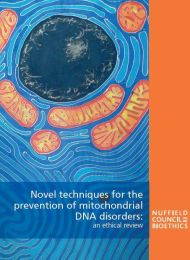Novel techniques for the prevention of mitochondrial DNA disorders: an ethical review
Report
Published 11/06/2012

Published in 2012
Inherited genetic disorders caused by mutated mitochondrial DNA are progressive and can cause a wide spectrum of severe health problems including heart and other major organ failures, stroke, dementia, blindness, deafness and premature death. Symptoms of these disorders can appear at any time from birth, on a wide range of severity. There is currently no cure for these disorders. New variations of IVF techniques are being developed that aim to replace damaged mitochondria by using part of a donated egg from a healthy individual. The intention is to allow women carrying disorders of mitochondrial DNA the chance to have healthy children that are genetically related to them, but born free of those disorders. Such techniques are not currently permitted for treatment use under UK legislation.
This report sets out the ethical considerations arising from the possible use of such techniques for treatment in the future. The issues that it discusses include:
- Implications for identity: the report considers a number of different notions of ‘identity’, discusses whether treatments for mitochondrial disorders might affect identity in some ways, and considers what significance this might have with regards to the acceptability of such treatments.
- Germline therapies: the Working Group concluded that donation treatments for mitochondrial disorders would constitute a form of germline gene therapy. The report discusses various concerns about germline therapies, and how treatments involving mitochondrial DNA might differ from other types of germline therapy.
- The introduction of novel techniques and follow-up of children: all treatments – new and established – are likely to involve some degree of risk and need to be regarded as experimental when first introduced. However, given the germline effects of mitochondrial donation techniques, particular issues are discussed concerning the ways in which any future treatment would need to be regulated and monitored, with follow-up of the families concerned.
- Parentage of the child: mitochondrial donation techniques involve the introduction of mitochondrial DNA from a donor, so the resulting child would be born with a genetic contribution from a third party. The report discusses the potential significance of this in biological, social and legal contexts.
- The status of the mitochondrial donor: the mitochondrial donor would go through the same procedures as a reproductive egg donor does when donating eggs for fertility treatments. The report considers whether the two types of donation should be treated in similar ways, or whether there are significant differences in terms of how the mitochondrial donor should be regarded, and the regulatory implications of this.
- Implications for wider society and future generations: some people suggest that as mitochondrial DNA is inherited from the egg, any future mitochondrial donation treatments should be limited to creating boys so that possible adverse future impacts will not be passed on. This issue is discussed, as well as questions about attitudes towards people with mitochondrial disorders, and about other possible future uses of the techniques.